Translate this page into:
Painful accessory navicular syndrome: A modified Kidner procedurenavicular
*Corresponding Author: Mugundhan Moongilpatti Sengodan, Department of Orthopedics, Institute of Orthopaedics and Traumatology, Coimbatore Medical College and Hospital, Coimbatore, Tamil Nadu, India mugundhan@yahoo.com
-
Received: ,
Accepted: ,
How to cite this article: Sengodan MM, Nityanandan K, Marasamy Y. Painful accessory navicular syndrome: A modified Kidner procedurenavicular. J Orthop Spine 2023;11:61-66. doi:10.25259/Joasp_30_23.
Abstract
Objectives
Painful accessary navicular syndrome is treated by various surgical methods after failed conservative treatment. The reason for the persisting pain, in all the surgically intervened cases, was degeneration of tibialis posterior tendon due to the need for dissecting the tendon in all the operative techniques described till date. So the surgical intervention for a painful accessary navicular syndrome should be done without disturbing the tibialis posterior tendon.
Material and Methods
We are presenting a surgical technique modifying the Kidner procedure while avoiding any damage to tibialis posterior tendon and a case series using our technique 11 patients underwent this procedure, of which ten were available for at least a two-year follow-up.
Results
The American orthopaedic foot and ankle society (AOFAS) ankle-hind foot score improved from 70 to 95 in the three-month follow-up and maintained till the final follow-up.
Conclusion
This modified Kidner procedure could be an effective technique in preventing persisting pain following the surgical treatment of the painful accessory navicular syndrome.
Keywords
Flip osteotomy
Kidner
Painful accessary navicular
Tibialis posterior tendon
INTRODUCTION
The developmental anomaly of accessory navicular is reported to be approximately 10—21% of population.1 The accessory navicular is classified into three types by Coughlin et al.2 Type II is most often the symptomatic one. The development of symptoms secondary to the presence of an accessory navicular have been reported to occur in 0.1% (1 in 1,000) of adult patients.3 Conservative treatment is advocated for painful accessory navicular in the form of casting, shoe modification, inserts and topical analgesics. Surgery is advocated only when adequate pain relief cannot be achieved despite conservative measures.4
Several surgical options like simple excision, excision and relocation of tibialis posterior tendon—Kidner procedure, per cutaneous drilling and fusion of synchondrosis with implants are available.1,3,5–7
Though most of the case series showed satisfactory outcome in many, still results are debatable with an overall rate of complication was one in five patients (18%) out of 273 feet in different studies.7
Ongoing pain after Kidner procedure is a concern. The reason for pain after Kidner procedure is postulated to be degenerative changes in tendon of tibialis posterior.7 Choi and Lee completed a review of clinical outcomes for nine patients who had undergone revision surgery after experiencing persistent pain after Kidner procedure.8
Hence many of the recent studies are in favour of simple excision of accessory navicular. But on detailed evaluation one third to half of the cases had persistent intermittent pain requiring foot wear modification or analgesics.9 Even when simple excision was chosen partial dissection of tendon of tibialis posterior was needed.7 And if the mother bone is prominent it was cut and shaved, during which again the tendon of tibialis posterior was further damaged.7
We wanted to avoid damage to tendon of tibialis posterior which is found to be the most common cause of persistent pain after surgical treatment of accessory navicular by modifying the Kidner procedure. We are presenting the surgical technique and a case series.
MATERIAL AND METHODS
This is a retrospective study on the clinical outcome of modified Kidner procedure in painful accessory navicular syndrome. We included all the patients who underwent this procedure at our institution from September 2017 to December 2021 and available for a minimum follow up of two years. During this period, 11 patients underwent this procedure, of which ten were available for at least two year follow up.
Nine of them were female and one was a male patient. Left foot was involved in three cases, right foot was involved in three cases and both feet involved in four cases. The age group was ranging from 16 to 19 years. Eight cases were of Coughlin type II, one case of type I and III each. All of them underwent a minimum of six months of conservative treatment in the form of medication, physiotherapy, foot wear modification and exercises before surgery.
Preoperative and postoperative clinical evaluations were performed using the American orthopaedic foot and ankle society (AOFAS) ankle-hind foot score and a ten-point visual analogue scale (VAS) for pain.
Radiographs of both feet anteroposterior and oblique views were taken preoperatively [Figure 1], immediate postoperative period and during follow up at four weeks, eight weeks, 12 weeks and at one year.
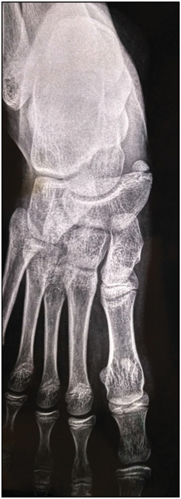
Surgical technique
Patient was placed in supine position under regional anaesthesia with tourniquet inflated. An oblique incision over the prominence on the medial aspect of foot was made [Figure 2]. Tendon of tibialis posterior was delineated over the navicular [Figure 3]. With 1.8 mm K wire multiple drill holes were made in the navicular parallel to the tendon of tibialis posterior, leaving 2–3 mm of bone attached to the tendon. An osteotomy was made by connecting the holes with an oscillating saw. Similar to a trochanteric flip osteotomy, the piece of bone with the tendon attached to it retracted medially and plantar ward [Figure 4]. Under image guidance a line is marked over the navicular which is in line with medial border of medial cuneiform. An osteotomy was made along this line in an oblique manner from dorsomedial to venterolateral direction, so that the prominent portion of the navicular is resected [Figures 5 and 6]. Usually this resection includes the accessory navicular along with it. Or in rare instance if it is attached to the flip osteotomy it could be removed from the osteotomy surface without damaging the tendon.
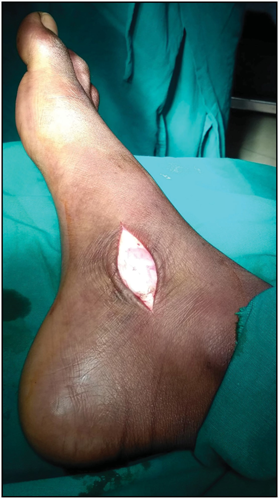
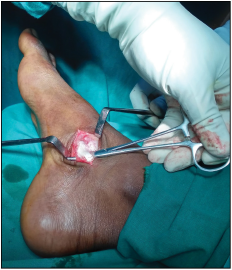

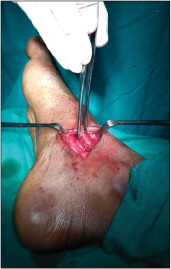
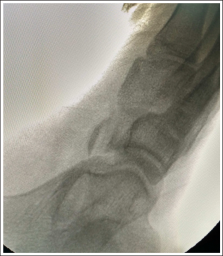
The resultant flat surface in the navicular bone will be oblique to which the tendon with the flake of bone is anchored using number 2 Ethibond [Figure 7]. While anchoring keep the part of the tendon distal to the bone under little tension. Tourniquet deflated and wound closed in layers after securing haemostasis. A below knee walking cast was applied for four weeks and partial weight bearing was allowed after two weeks. After four weeks cast was removed and full weight bearing was allowed.
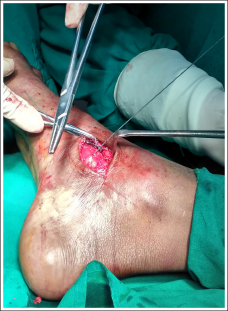
RESULTS
In all the patients the osteotomy site healed within 12 weeks. The AOFAS ankle-hind foot score improved from 70 to 95 in three months follow up and maintained till final follow up.
The ten-point VAS for pain improved from an average of 8 to 1 during the 3rd month follow up and maintained till final follow up.
Follow up radiographs at one year showed union in all the cases [Figure 8].
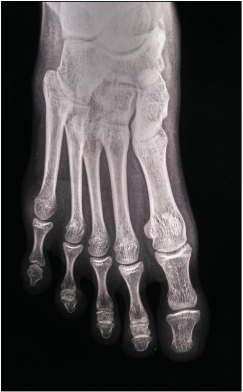
As the sample size was too small and no comparative or control group were available for the study no further statistical analysis was done.
DISCUSSION
Persisting pain is the main concern in a case of painful accessary navicular syndrome as the name implies. Hence the treatment is focused on alleviating the pain. Not all the accessary navicular are painful and many of those have pain also gets better on conservative treatment.1,3,5,6 Only cases which have persistent pain even after six months of conservative treatment fall into the category of painful accessary navicular syndrome requiring surgery.
Only limited studies involving small case series are published about the surgical intervention for painful accessary navicular syndrome. Of which few of the studies are concerned about the ongoing pain after either simple excision or Kidner procedure.7–9
The relationship between painful accessory navicular and flatfoot is controversial, and it is not clear whether flatfoot is the cause of painful accessory navicular or vice versa. Vaughan and Singh reported that pes planus may contribute to ongoing pain after excision of the accessory navicular.7
Hong Joon Choi and Woo Chun Lee believed that both planovalgus and hind foot valgus deformities can be associated with recurrent pain after the Kidner procedure, because both flatfoot and hind foot valgus can increase the tension on the Tibialis posterior tendon and result in degeneration of the tendon, thereby causing recurrent pain.8 Painful scars reported by Vaughan et al could also be possibly due to adherence of damaged tibialis posterior tendon to the scar tissue.7
To avoid problems associated with the Kidner procedure, the accessory navicular should be soundly fused to the mother bone. However, secure fixation of such a small bone is difficult, and assessment of the progression of the fusion is challenging owing to the small opposing surfaces between the accessory bone and the body of the navicular.1
The reason for the persisting pain, in all the surgically intervened cases, was degeneration of tibialis posterior tendon due to the need for dissecting the tendon in all the operative techniques described till date.5,7–9
So the surgical intervention for a painful accessary navicular syndrome should be done without disturbing the tibialis posterior tendon as described in our technique. By doing a flip osteotomy and addressing the synchondrosis from the under surface of the flip, there was no need for dissecting the tendon.
The Tibialis posterior tendon has multiple insertions besides the primary insertion at the navicular. Jeong-Hyun Park, Digud Kim et al in their cadaveric study of 118 feet observed four different patterns of insertion of tibialis posterior tendon. The most common type was type 4 (quadruple insertions, 78 feet, 66.1%). The second most common type was type 3 (triple insertions, 25 feet, 21.2%). Type 2 was found in 13 feet (11%), and the rarest type was type 1 (2 feet, 1.7%), wherein the main tendon was only attached to the navicular bone and the medial cuneiform bone. In all four types the major insertion is into the navicular and medial cuneiform.10 This anatomical consistency would enable our flip osteotomy in any type of insertion pattern.
In our small series of cases the outcome was promising as there was significant improvement in AOFAS ankle—hind foot score and VAS score in all the patients. However large number of cases as a multicentre study is necessary to strongly recommend this procedure.
CONCLUSION
This modified Kidner procedure could be an effective technique in preventing persisting pain following the surgical treatment of painful accessory navicular syndrome. We presented our surgical technique in which the tibialis posterior tendon is not disturbed while performing a procedure principally similar to that of Kidner.
Ethical approval
Institutional Review Board approval is not required as it is a retrospective study.
Declaration of patient consent
The authors certify that they have obtained all appropriate patient consent.
Financial support and sponsorship
Nil
Conflicts of interest
There are no conflicts of interest.
Use of artificial intelligence (AI)-assisted technology for manuscript preparation
The authors confirm that there was no use of artificial intelligence (AI)-assisted technology for assisting in the writing or editing of the manuscript and no images were manipulated using AI.
REFERENCES
- Assessing the outcomes associated with accessory navicular bone surgery-a systematic review. Curr Rev Musculoskelet Med. 2022;15:377-84.
- [CrossRef] [PubMed] [Google Scholar]
- *Sesamoids and accessory bones of the foot. In: Mann’s Surgery of the Foot and Ankle, 9th Edn. Mosby: Maryland Heights 2014:544-51.
- [Google Scholar]
- Simple excision vs the Kidner procedure for type 2 accessory navicular associated with flatfoot in pediatric population. Foot Ankle Int. 2013;34:167-72.
- [CrossRef] [PubMed] [Google Scholar]
- Effectiveness of nonoperative treatment of the symptomatic accessory navicular in pediatric patients. Iowa Orthop J. 2019;39:45-9.
- [PubMed] [Google Scholar]
- A retrospective study on factors predictive of operative intervention in symptomatic accessory navicular. J Child Orthop. 2019;13:107-13.
- [CrossRef] [PubMed] [Google Scholar]
- Comparison of outcomes of arthrodesis and reconstruction (advancement), posterior tibial tendon with excision of accessory tarsal navicular bone (Kidner procedure) in type 2 accessory navicula. Foot Ankle Surg. 2020;26:930-4.
- [CrossRef] [PubMed] [Google Scholar]
- Ongoing pain and deformity after an excision of the accessory navicular. Foot Ankle Clin. 2014;19:541-53.
- [CrossRef] [PubMed] [Google Scholar]
- Revision surgery for recurrent pain after excision of the accessory navicular and relocation of the tibialis posterior tendon. Clin Orthop Surg. 2017;9:232-8.
- [CrossRef] [PubMed] [Google Scholar]
- Outcomes following revision surgery after failed kidner procedure for painful accessory navicular. Foot Ankle Int. 2020;41:1493-501.
- [CrossRef] [PubMed] [Google Scholar]
- A new anatomical classification for tibialis posterior tendon insertion and its clinical implications: A cadaveric study. Diagnostics. 2021;11:1619.
- [CrossRef] [PubMed] [Google Scholar]






